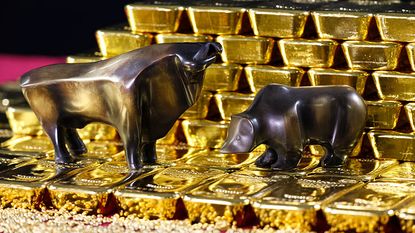How to invest in gold
Investing in gold can be a useful way to diversify your portfolio and offers protection when the stock markets struggle. We explain how to invest in gold


If you want to protect your investment portfolio from market uncertainty, it’s worth learning how to invest in gold.
Gold is seen as an investment insurance policy as its value and performance don’t correlate to other assets. As a result, it tends to hold its worth and can become more desirable when markets take a turn or when inflation is high. That makes investing in gold an appealing prospect in the current economic environment.
Here, we explain how to invest in gold and add some protection to your investment portfolio.
Subscribe to MoneyWeek
Subscribe to MoneyWeek today and get your first six magazine issues absolutely FREE

Sign up to Money Morning
Don't miss the latest investment and personal finances news, market analysis, plus money-saving tips with our free twice-daily newsletter
Don't miss the latest investment and personal finances news, market analysis, plus money-saving tips with our free twice-daily newsletter
How to invest in physical gold
One way to add gold to your portfolio is by buying physical gold, or bullion, in the form of bars and coins.
Physical gold can be purchased from government mints, such as the UK’s Royal Mint, precious metal dealers, such as Goldcore, and jewellers.
It is an unregulated market though so there is a risk of scams. One way to protect yourself is to always check whether a dealer is part of the London Bullion Market Association, which sets common standards across the industry.
As with any investment, it is important to do your research on prices. Gold dealers make their money by selling for more than the spot price and buying for less. The difference – or spread – will vary depending on the gold content and weight of the bullion, who you buy from, and current supply and demand.
There are tax advantages to investing in physical gold as there is no stamp duty or VAT to pay on purchases.
Additionally, there is no capital gains tax to pay on sales of coins produced by the Royal Mint, including the popular Britannias and gold sovereigns, as they are classed as legal tender.
Gold coins can have more value than bars as they may be rarer and are often viewed as collectables, known as semi-numismatic coins.
The one-ounce South African Krugerrand, first produced in 1967, is the most common gold coin and normally trades at the cheapest premium over the spot price.
Other popular coins are the UK gold sovereign, which is 22-carat gold, and the one-ounce Britannia.
However, as attractive as buying a gold bar or coin may be, you will also have to consider delivery and insurance costs, and the cost of safe storage.
One solution may be using an online investment service, such as BullionVault and GoldMoney, which let you invest in gold bars or coins that are then stored in their own vaults.
The Royal Mint also has a digital option that lets you invest in physical gold, silver or platinum based on monetary value instead of weight. It can then be stored in the Royal Mint’s vault.
If you want to use your gold for spending, apps such as Tally or Glint allow you to invest in gold stored in Switzerland. The gold is then converted into credits that can be used to make purchases using the app or a branded debit card.
How to invest in gold ETFs
A simpler and cheaper way to invest in gold is through Exchange traded funds (ETFs) or exchange traded commodity (ETC) products. Take a look at our article on the best gold ETFs for more.
Analysts favour physical-backed ETFs or ETCs, such as iShares Physical Gold, over leverage-style products that rely on derivatives to boost returns, adding extra costs and complexity.
“An ETC owns physical gold and tracks the price,” says Ben Yearsley, investment director at Shore Financial Planning.
“It’s as close as most people get as it’s simple and can be held in your Sipp and Isa.”
The main costs of investing in gold ETFs will be the ongoing charge and any platform fees.
You won’t actually own any gold but, as with holding the physical asset, you will benefit from any growth in prices.
Your portfolio will also take a hit if the gold price drops.
How to invest in gold mining stocks
Rather than buying actual gold, it is worth considering how to invest in backing the companies involved in gold exploration or mining.
This would mean buying shares in gold mining stocks.
This requires more research than tracking the gold price, as a company’s success will be linked to its own exploration activities, business strategy and performance.
Rob Morgan, chief investment analyst at Charles Stanley, describes backing mining stocks as a higher-risk route.
“Profits can be highly sensitive to what the gold price is doing, and the riskier firms could even swing from profit to loss or vice versa on these moves,” he says.
How to invest in gold funds
If you don’t have the time or aren’t confident enough to do the research into gold mining firms yourself, a better option may be investing in gold funds.
With a gold investment fund, the investment firm does the research for you to build a diversified portfolio across different mining companies.
For example, BlackRock Gold & General backs 50 to 80 companies, mainly focused on gold mining and producers.
You could also invest across different metals and mining shares with Jupiter Gold and Silver or the Amati Strategic Metals fund.
“Mining companies have different drivers of return than physical gold but should benefit when the price of gold increases as they should have a fixed or stable cost to mine it but can sell at a higher price,” adds Yearsley.
“One key benefit of gold mining companies is they make a profit and pay dividends.”
The pros and cons of investing in gold
There are plenty of pros and cons to consider, irrespective of how you invest in gold.
Advocates of gold investment see the asset as a useful diversifier when many others are correlated.
“It is often said investing in gold helps fight inflation,” adds Morgan.
“In contrast to paper currencies such as the pound or the dollar, which can lose their spending power over time as more are created, there is a finite supply of gold. Only a small amount is added to the supply each year from mining.”
Samuel Mather-Holgate, an adviser at Mather and Murray Financial, says gold has been an intrinsic store of value for centuries – making it a useful hedge against inflation – and a go-to asset in uncertain times.
“That's certainly what we are in at the moment, so we should be seeing a surge in gold prices,” he says.
“However, because the dollar is so strong, as it's also a popular investment during periods of volatility, gold hasn't seen as much of a bounce as expected yet. The greenback's strength won't continue forever.”
Critics cite the lack of income you can get from physical gold or through ETFs which don’t pay dividends. What’s more, the price of gold can be volatile over the short or medium term, making it hard to know if you are buying at the top or bottom of the market.
“Ultimately, most investors hold gold within a portfolio because it dances to its own beat,” says David Henry, investment manager at Quilter Cheviot.
“The asset has historically moved in different directions to other traditional portfolio investments, seemingly at random.
“It can help risk-conscious investors diversify their wealth. Just bear in mind that there are no guarantees that gold will rise when stocks or bonds fall.”
Investing in gold ‒ how is gold expected to perform?
If you are looking to invest in gold, it is worth considering how it has performed in the past. While past performance is no guarantee of future returns, it is notable that the gold price has been on the rise over the past year.
For example, as of the end of July 2023, an ounce of gold was priced at $1,958, that is up from $1,714 at the same time last year - a rise of 14.2%.
In July 2018, it stood at $1,231, meaning it has risen by 39% over the past five years.
By comparison, the FTSE All Share Index is down 1.32% over the past five years.
Timing is important though and can be hard to predict. If you had invested in gold three years ago, you would have got a price of $1,936, which rose to a high of $2,067 in August but your return would be just 1.1%.
“Against a weak pound, gold is not far off its all-time highs, so it has done a reasonable job of preserving wealth in what has been a very difficult year,” adds Morgan.
“Longer term, the prospect of inflation becoming embedded and the potential for greater geopolitical instability could be positive factors for the gold price.”
But he warns that gold is still vulnerable to the increasing competitiveness of returns on other financial assets.
You may be able to add some gold investments to your stocks and shares Isa if you have one.
- We have compiled a directory of leading gold brokers where you can buy gold bullion, coins and bars online, over the phone or even in branch: How and where to buy gold coins and bars.
Marc Shoffman is an award-winning freelance journalist specialising in business, personal finance and property. His work has appeared in print and online publications ranging from FT Business to The Times, Mail on Sunday and The i newspaper. He also co-presents the In For A Penny financial planning podcast.
-
-
 Top-quality small companies with big scope for long-term growth
Top-quality small companies with big scope for long-term growthA professional investor tells us where he’d put his money. This week: Dr Gareth Blades, analyst at Amati Global Investors, highlights three favourites.
By Nicole García Mérida Published
-
 Starling Bank hikes fixed savings rate to 5.25%
Starling Bank hikes fixed savings rate to 5.25%Starling Bank has hiked the rate on its fixed savings which has shot up from 3.25% to 5.25% - but how does it compare to the rest of the market?
By Vaishali Varu Published
-
 Investing in wine: how Cru Wine is reaching new audiences
Investing in wine: how Cru Wine is reaching new audiencesTips Gregory Swartberg, founder of fine wine specialist Cru Wine, talks to Chris Carter about how to start a wine collection
By Chris Carter Published
-
 Small companies with big potential
Small companies with big potentialMichael Taylor of Shifting Shares reviews his 2023 picks and highlights more promising minnows.
By Michael Taylor Published
-
 The MoneyWeek portfolio of investment trusts – July 2023 update
The MoneyWeek portfolio of investment trusts – July 2023 updateTips A decade ago we set up the MoneyWeek portfolio of investment trusts. They remain a compelling long-term bet says Rupert Hargreaves
By Rupert Hargreaves Published
-
 Women lead the way with ethical investments
Women lead the way with ethical investmentsDemand for more ethical investments has soared – and women are more likely to opt for them. Annabelle Williams, personal finance specialist at Nutmeg, takes a look at why.
By Annabelle Williams Published
-
 BoE: Mortgage payments to rise by £220 a month for households
BoE: Mortgage payments to rise by £220 a month for householdsMillions of households can expect a mortgage spike of around £200 a month - and some may even reach a extra £1,000 a month, the Bank of England warns
By Marc Shoffman Published
-
 What happened to Thames Water?
What happened to Thames Water?Thames Water, the UK’s biggest water company could go under due to mismanagement and debt. We look into how the company got itself into this position, and what investors should expect.
By Simon Wilson Last updated
-
 Where to invest in the metals that will engineer the energy transition
Where to invest in the metals that will engineer the energy transitionA professional investor tells us where he’d put his money. This week: John Ciampaglia, manager of the Sprott Energy Transition Materials UCITS ETF.
By Nicole García Mérida Published
-
 How investors can profit from high food prices
How investors can profit from high food pricesThe latest furore over grocery prices will die down, says David Stevenson. But the long-term outlook for soft commodities remains bullish. These are the stocks investors can buy to profit from high food prices.
By David J Stevenson Published









